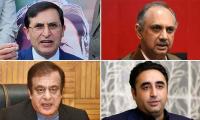Khadim Hussain Rizvi, who recently passed away, had risen to prominence in a short period on the politico-religious landscape of Pakistan. His reputation rested on two things: the ability to agitate on the highly sensitive issue of blasphemy so successfully as to bring the government on its knees; and speaking with a sense of no-holds-barred and brutally stigmatizing anyone – including the clergy – who dared to question his tactics.
Thus in 2017 and later in 2020, on both occasions in November, his party the Tehreek-e-Labbaik Pakistan (TLP) demonstrated its capability to throw life in the twin cities of Rawalpindi and Islamabad into a tailspin. On both the occasions, the party forced the government of the time to strike a deal on the former’s terms.
As in the case of most other religio-political leaders in Pakistan, Rizvi dominated his organization so completely that his sudden demise has put its future under question. Although the late leader has been succeeded by his son – in keeping with the prevailing political norms – it remains to be seen whether the new TLP chief will be as effective as his father was.
More important than the TLP is the narrative that it espouses – though it must be admitted that the party has been a cut above the rest in whipping up its followers’ sentiments to the point of frenzy – which will remain virile. Seen in a broader context, the rise of the TLP is part of the ascendency of right-wing parties, which has been the seminal political development taking place in recent years.
Right-wing parties may be classified into two categories: One category comprises religio-political outfits, such as the two factions of the Jamiat Ulema-e-Islam (JUI), Jamiat Ulema-e-Pakistan (JUP), the Jamaat-e-Islami (JI), and now the TLP. The last mentioned represents the Barelvi sub-sect, the largest Muslim sub-sect in Pakistan. The party gets its inspiration from the execution of Mumtaz Qadri, the assassin of Punjab Governor Salmaan Taseer. The governor was gunned down by one of his guards for being critical of the blasphemy law. In the eye of a considerable section of society, even a soft criticism of the blasphemy law is itself blasphemous and thus constitutes an unpardonable act.
The religious parties are strong exponents of subordinating politics to religion, using the state machinery to make people ‘good’ Muslims – as per their interpretation – and punish those who do not measure up to their standards.
The other right-wing category consists of mainstream conservative political parties, like the Pakistan Muslim League-Nawaz (PML-N) and the Pakistan Tehreek-e-Insaf (PTI). Unlike religious parties, their support is broad-based and is not confined to a particular creed or sect. But they do make an appeal to the religious vote-bank as well as strike electoral alliances with religious outfits. These parties play upon religious sentiments when doing so they find it to their advantage. The PML-N in recent years has sought to reposition itself as the party of the centre-right. Former prime minister Nawaz Sharif on quite a few occasions declared that he represented all the citizens and not merely Muslims – for which he was rounded on by the clergy.
In its inaugural general elections in 2018, the TLP fielded 571 candidates including 178 for the National Assembly. Although it secured only two provincial assembly seats – significantly enough, both in Karachi – the party emerged as the fifth largest party nationwide with 2.2 million votes, accounting for 4.2 percent of the total votes cast, narrowly behind the relatively moderate clergy alliance MMA’s 2.56 million votes. In the Punjab province and the two biggest cities each, the TLP finished third in terms of votes obtained.
In order to explain the rise of the TLP, we need to briefly and broadly take stock of the circumstances that condition political parties’ birth and growth. Political parties grow out of the cleavages present in a society. Typically, these include political ideology, creed, ethnicity, location, caste or race and social class. The relative importance of these divisions across societies as well as within a society over time depends primarily on social ethos. In Pakistan, a multiethnic, multi-faith society, creed (religion or sect) and ethnicity have constituted far more significant cleavages than social class. This explains why society has not yet seen the rise of a workers’ party. Cleavage consciousness is thus a fundamental condition for the rise of a political party.
This has been at work in the case of the rise of the TLP as well. Barelvi political parties, such as the JUP, have contested national elections since 1970. The electoral appeal of these relatively moderate parties remained largely confined to urban Sindh, notably Karachi. Other sects or sub-sects have also had their political parties. Over the years, the electorate has not been much impressed with religious parties and overwhelmingly voted for the mainstream political parties.
The rise of the MQM in the mid-1980s strengthened the ethnic cleavage in urban Sindh at the expense of religious parties. As a result, parties like the JUP were reduced to a rump. In other parts of the country, the Barelvi vote bank was mainly captured by the PML-N. Despite the presence of the Barelvi-Deobandi cleavage, an electorally viable political party could not be mobilized. The efforts of Allama Tahirul Qadri, a renowned Barelvi scholar who founded the Pakistani Awami Tehreek, to make a niche for himself in electoral politics also came to grief. Disillusioned with the electorate, he reposed his faith in agitation politics.
Both the events – the execution of Mumtaz Qadri and the promulgation of the Election Act, 2017 – which catapulted the TLP into popular politics took place when the PML-N, Barelvis’ first electoral choice, was in the saddle. The TTP’s rise was also aided by the changing political ethos under which politics has become largely a squalid affair in which demonizing rivals, showing zero tolerance for dissent, and the ability to command mindless submission from supporters have come to be prized as the foremost virtues of a leader. The TLP made adroit use of social media where the audience is remarkably impressionable and can be beguiled with myth-spinning without much ado.
Unlike most mainstream parties, the TLP’s leadership is drawn from the lower middle and bottom of the economic heap. Rizvi himself was a man of humble origins. Those two factors placed him in an excellent position to garner support of the underprivileged sections of society. The combination of religion and economics that the TLP represents may turn out formidable if the people are convinced that their economic plight is underpinned by the prevalence of an ‘un-Islamic’ culture and system.
The ascendency of the right-wing parties started with the 2013 general elections, which resulted in their overwhelming victory and defeat of the progressive parties. The 2018 elections were also largely a contest among the right-wing parties.
The rise of right-wing politics is a matter of grave concern, because mixing religion and politics is a dangerous game for a multi-creed polity like Pakistan. The edifice of such a society must rest on the pillars of a pluralistic philosophy, which accepts diversity of beliefs, practices and codes without trying to reduce the diversity to a unity. In such a society if the social order is to work smoothly, religion should not be used for political purposes, because this invariably promotes one community at the expense of others.
Email: hussainhzaidi@gmail.com
Twitter: @hussainhzaidi
The writer is an Islamabad-based columnist.
On January 29 this year, mid-air collision, first major US aviation accident since 2009, challenged this optimism
Until these ideological foundations are dismantled, cycle of extremism will continue
Public needs to realise that only education can make Pakistan better place to live in
Trade war initiated by US has also resulted in alienation of critical allies, who found themselves ensnared in conflict
What Washington needs to register is that terrorism is threat not only to Pakistan but also to US and its allies
Global superpowers are weaponising blockchain to assert financial dominance







